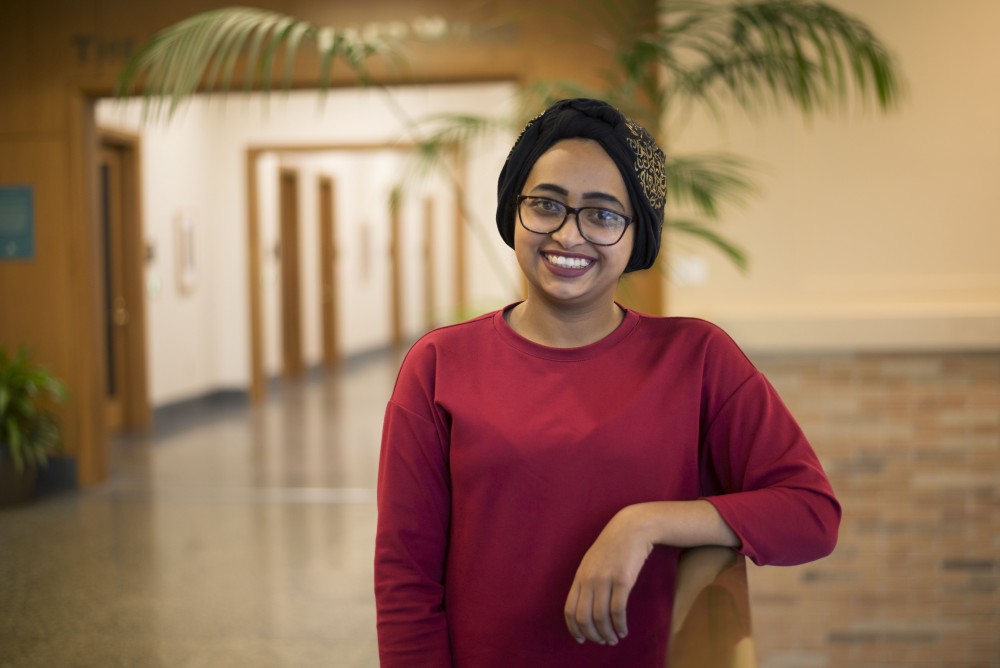‘Voicing the Voiceless’

GVL / Luke Holmes – Amina Mohamed poses in the Seiman College of Business.
Oct 3, 2016
With the continued influx of immigrants and refugees into the U.S., American schools are becoming increasingly diverse as they fill with students from different cultural environments. Nevertheless, despite this upsurge in diversity within the classroom, some educators think the literature taught in American schools fails to represent the broad scope of students’ unique backgrounds.
Amina Mohamed, an English language interventionist in Kentwood Public Schools and a graduate student at Grand Valley State University, wants to change that. In her paper, “Voicing the Voiceless,” Mohamed draws from her own experiences growing up in Abu Dhabi and the experiences of her students to emphasize the need for multicultural literature in schools.
“I think if we go around right now and look at classrooms in the United States, we’ll come to realize that minority students are becoming the majority,” Mohamed said. “One way that teachers can deal with that diversity is to serve the students by giving them books they can relate to.”
Growing up in the Middle East and attending a private American school, Mohamed experienced firsthand a lack of cultural diversity in American literature.
“(In) all the books that we read narrated by American authors, all the characters were white,” she said. “To me, it was just the norm. To me, being American meant being white. And it took me coming to the U.S. and understanding the history of the U.S. to understand that no, being American means a lot of things and not just white.”
Mohamed’s paper will be published in the Language Arts Journal of Michigan (LAJM), a scholarly, peer-reviewed publication with an emphasis in English education and pedagogical practices. She said her target audiences are current teachers and professors educating pre-service teachers.
“Teachers have to go out of their way to bring books that have characters that are not white,” Mohammed said. “It’s not something that naturally happens in the classroom. I think it’s going to take a few years before we reach a point where it’s natural for us to go to a bookstore and find children of color represented, but I think it needs to be very natural and very normal.”
In her paper, Mohamed offers some practical advice for how teachers can include multicultural literature in their classrooms.
“I have my story and the story of my students explaining the importance of multicultural literature, and then I also have a few tips on how to pick multicultural books and how to teach them in the class,” she said.
Mohamed’s paper is an adaptation from her English capstone thesis, which she completed in the spring of 2015. With the encouragement and advice of her professor, Brian White, Mohamed revisited her thesis a year later and reworked it to adjust the language and include more personal stories before submitting it for publication.
“Amina brings this great authority because of her personal experience,” White said. “I grew up seeing myself represented in literary works, and she didn’t. Her story is powerful in part because it’s her story.
“No one else can tell that story the way she can tell it.”
For Mohamed, the importance of sharing her story and addressing the lack of multicultural literature in schools goes far beyond herself.
“I think the implications (of getting this paper published) aren’t so much for me. I think of my students more than anything,” Mohamed said. “They are kids who are coming with knowledge, and it’s our job to build on that knowledge rather than assume what we want them to know. Background knowledge is built by books, and it’s important that we pick the right books for our kids.
“I really hope, maybe not today, maybe not tomorrow, but years from now, that I can walk into a class and see multicultural books as being the norm with all the other books.”

























